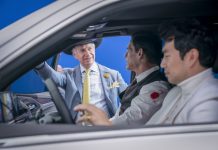In July of 1987, came to theaters, depicting sci-fi that seemed more fiction than it did science. With cyborgs, handheld tracking maps, memory recording, and killer robots, the film was a sensation, presenting a downtrodden version of Detroitтs future alongside the amazing technology that same future could offer.
Now, just over 35 years after the filmтs release, weтre finding that much of the filmтs futuristic technology isnтt actually that far off. While we may not be able to resurrect people as cyborgs and memory-wiping is still considered highly unethical, there is complex, experimental technology being developed now that rivals that of RoboCop.
Movies like RoboCop have helped inspire scientists who have in turn worked to bring that fictional technology to life. As Rob Spence т a documentary filmmaker known as the Eyeborg (more on him in a minute) т says, тWild imaginations create these things no one thought was possible.т
And just like that, here we are, 35 years later, turning technology from RoboCop into a reality.
Hereтs a look at some RoboCop tech thatтs no longer a fantasy.
Artificial Intelligence
The AI we see in 2022 is able to serve society by doing things humans cannot, but it is vastly different from RoboCopтs ED-209 т a hulking robot designed to either stop bad guys or blow them to smithereens. The AI represented in RoboCop is more computer-like than brain-like. One of the primary conflicts in RoboCop comes from the fact that the ED- 209 performs human-like functions but lacks humanness.
тWith machines, itтs difficult to get human nuances,т says Kevin Warwick, a leading researcher on AI and cyborg technology. The artificial intelligence we have today is advanced but in different ways than depicted in RoboCop.
Location Tracking
RoboCop has a locator device in his armor that allows his creators to track him. This is done on a small, handheld map that serves as an active GPS locator. While GPS was technically available to the public starting in 1983, the first handheld device didnтt come out until 1989 т and that looked more like a clunky calculator. The GPS on our phones today can do something far more similar to that in RoboCop, allowing maps to track peopleтs movements. The tracking devices in the film are even shaped like modern-day smartphones!
Cyborgs
A cyborg is someone who is part human, part machine. Cyborgs akin to RoboCop are a long way off, but with people today carrying implanted chips that allow emergency information storage, electronic payment methods, electronic keys, as well as things like surgical additions that help people experience unique senses, our world is home to many such cyborgs. Todayтs cyborgs are still more human than they are technology, primarily using cyborg technology as an aid rather than an enhancement.
Thermographic Vision
Modern thermographs work very similarly to RoboCopтs thermographic vision, the only difference being that our thermographs arenтt a part of the body and cannot see through walls. However, it turns out there are other waysЬ§to detect heat signals. A pioneer in the world of a new artistic field called cyborg art, Neil Harbisson is color- blind, but because of an antenna implanted into his skull, he is able to hear the vibrations of different colors, including infrared.
тItтs a way of transforming technology into senses,т Harbisson says. In that way, he is able to sense infrared radiation, though in a different way from RoboCop.
Heads-Up Displays
RoboCopтs eyes are equipped with a digital heads-up display т which gives digital information corresponding to the world heтs observing т that allows him to identify targets, among other things. His digital eyesight is incredible, but this technology is not yet realistic for modern times.
Ocularist PhilЬ§Bowen says that eye transplants are decades out, and thatтs not even factoring in the digital enhancements.
Recording Memories
An incredible feature RoboCop has because of his digital sight is the ability to record his experiences fromЬ§a first-person point of view. Spence, the aforementioned filmmaker, lost his right eye as a child. Known as the Eyeborg, Spence has a unique prosthetic eye that houses a small video camera. He canтt see from that eye, but it can capture footage from a first-person point of view thatЬ§then connects to other devices.
This story is from the September 2022 issue of ЬЧаФvlogАВзПАц.Ь§Read more inЬ§our digital edition.Ь§
|
| Ь§ |
|








